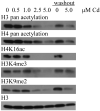Gene expression and pathway analysis of human hepatocellular carcinoma cells treated with cadmium
- PMID: 26314618
- PMCID: PMC4605876
- DOI: 10.1016/j.taap.2015.08.011
Gene expression and pathway analysis of human hepatocellular carcinoma cells treated with cadmium
Abstract
Cadmium (Cd) is a toxic and carcinogenic metal naturally occurring in the Earth's crust. A common route of human exposure is via diet and cadmium accumulates in the liver. The effects of Cd exposure on gene expression in human hepatocellular carcinoma (HepG2) cells were examined in this study. HepG2 cells were acutely-treated with 0.1, 0.5, or 1.0 μM Cd for 24h; or chronically-treated with 0.01, 0.05, or 0.1 μM Cd for three weeks and gene expression analysis was performed using Affymetrix GeneChip® Human Gene 1.0 ST Arrays. Acute and chronic exposures significantly altered the expression of 333 and 181 genes, respectively. The genes most upregulated by acute exposure included several metallothioneins. Downregulated genes included the monooxygenase CYP3A7, involved in drug and lipid metabolism. In contrast, CYP3A7 was upregulated by chronic Cd exposure, as was DNAJB9, an anti-apoptotic J protein. Genes downregulated following chronic exposure included the transcriptional regulator early growth response protein 1. Ingenuity Pathway Analysis revealed that the top networks altered by acute exposure were lipid metabolism, small molecule biosynthesis, cell morphology, organization, and development; while top networks altered by chronic exposure were organ morphology, cell cycle, cell signaling, and renal and urological diseases/cancer. Many of the dysregulated genes play important roles in cellular growth, proliferation, and apoptosis, and may be involved in carcinogenesis. In addition to gene expression changes, HepG2 cells treated with cadmium for 24h indicated a reduction in global levels of histone methylation and acetylation that persisted 72 h post-treatment.
Keywords: Affymetrix; Cadmium; Epigenetics; Gene expression; HepG2 cells; Histone modifications.
Copyright © 2015 Elsevier Inc. All rights reserved.
Figures





Similar articles
-
Gene expression alterations of human liver cancer cells following borax exposure.Oncol Rep. 2019 Jul;42(1):115-130. doi: 10.3892/or.2019.7169. Epub 2019 May 23. Oncol Rep. 2019. PMID: 31180554 Free PMC article.
-
Characterization of the cellular response during apoptosis induction in cadmium-treated Hep G2 human hepatoma cells.Biol Trace Elem Res. 2003 Nov;95(2):139-53. doi: 10.1385/BTER:95:2:139. Biol Trace Elem Res. 2003. PMID: 14645995
-
The expression and effects the CABYR-c transcript of CABYR gene in hepatocellular carcinoma.Bull Cancer. 2012 Mar 1;99(3):E26-33. doi: 10.1684/bdc.2011.1538. Bull Cancer. 2012. PMID: 22285430
-
DNA microarray analysis of altered gene expression in cadmium-exposed human cells.J Occup Health. 2003 Nov;45(6):331-4. doi: 10.1539/joh.45.331. J Occup Health. 2003. PMID: 14676411 Review.
-
The Role of Histone Acetylation-/Methylation-Mediated Apoptotic Gene Regulation in Hepatocellular Carcinoma.Int J Mol Sci. 2020 Nov 24;21(23):8894. doi: 10.3390/ijms21238894. Int J Mol Sci. 2020. PMID: 33255318 Free PMC article. Review.
Cited by
-
Chronic cadmium exposure aggravates malignant phenotypes of nasopharyngeal carcinoma by activating the Wnt/β-catenin signaling pathway via hypermethylation of the casein kinase 1α promoter.Cancer Manag Res. 2018 Dec 19;11:81-93. doi: 10.2147/CMAR.S171200. eCollection 2019. Cancer Manag Res. 2018. PMID: 30588112 Free PMC article.
-
Integrative Analysis of Metallothioneins Identifies MT1H as Candidate Prognostic Biomarker in Hepatocellular Carcinoma.Front Mol Biosci. 2021 Oct 5;8:672416. doi: 10.3389/fmolb.2021.672416. eCollection 2021. Front Mol Biosci. 2021. PMID: 34676244 Free PMC article.
-
LncRNA-ENST00000446135 is a novel biomarker of cadmium toxicity in 16HBE cells, rats, and Cd-exposed workers and regulates DNA damage and repair.Toxicol Res (Camb). 2020 Dec 10;9(6):823-834. doi: 10.1093/toxres/tfaa088. eCollection 2020 Dec. Toxicol Res (Camb). 2020. PMID: 33447366 Free PMC article.
-
Gene expression alterations of human liver cancer cells following borax exposure.Oncol Rep. 2019 Jul;42(1):115-130. doi: 10.3892/or.2019.7169. Epub 2019 May 23. Oncol Rep. 2019. PMID: 31180554 Free PMC article.
-
Increased expression of LncRNA BANCR and its prognostic significance in human hepatocellular carcinoma.World J Surg Oncol. 2016 Jan 12;14(1):8. doi: 10.1186/s12957-015-0757-5. World J Surg Oncol. 2016. PMID: 26758762 Free PMC article.
References
-
- Cadmium and Cadmium Compounds. 13 ed. Report on Carcinogens. 2014: National Toxicology Program, Department of Health and Human Services.
-
- Satarug S, Haswell-Elkins MR, Moore MR. Safe levels of cadmium intake to prevent renal toxicity in human subjects. Br J Nutr. 2000;84(6):791–802. - PubMed
-
- Bernard A. Cadmium & its adverse effects on human health. Indian J Med Res. 2008;128(4):557–64. - PubMed
-
- Wang B, et al. Cadmium and its epigenetic effects. Curr Med Chem. 2012;19(16):2611–20. - PubMed
Publication types
MeSH terms
Substances
Grants and funding
LinkOut - more resources
Full Text Sources
Other Literature Sources
Research Materials

